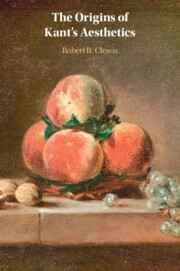Book contents
- The Origins of Kant’s Aesthetics
- The Origins of Kant’s Aesthetics
- Copyright page
- Dedication
- Contents
- Figures
- Acknowledgments
- A Note on Citations
- Abbreviations
- Introduction
- Part I Aesthetic Judgment and Beauty
- Part II Genius and the Fine Arts
- Part III Negative and Positive States
- Closing Reflections
- Bibliography
- Index
Closing Reflections
Published online by Cambridge University Press: 10 January 2024
- The Origins of Kant’s Aesthetics
- The Origins of Kant’s Aesthetics
- Copyright page
- Dedication
- Contents
- Figures
- Acknowledgments
- A Note on Citations
- Abbreviations
- Introduction
- Part I Aesthetic Judgment and Beauty
- Part II Genius and the Fine Arts
- Part III Negative and Positive States
- Closing Reflections
- Bibliography
- Index
Summary
The closing remark offers three points for further reflection. First, Kant’s Critique of the Power of Judgment is full of inner tensions. Some of them can be traced back to his working through various sources and to his drawing from different aspects of his earlier views. Second, Kant’s early aesthetics may have more to offer than scholars and commentators realize, and some of his early ideas are worth examining more closely. In addition, his mature or Critical account continues to inform current discussions in the philosophy of art and art criticism. Third, not all of Kant’s ideas, whether early or late, can be readily applied to aesthetic theory and philosophy of art today.
Keywords
- Type
- Chapter
- Information
- The Origins of Kant's Aesthetics , pp. 241 - 242Publisher: Cambridge University PressPrint publication year: 2023

